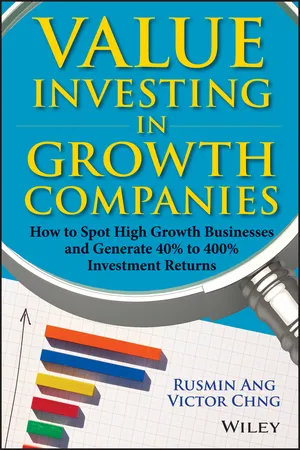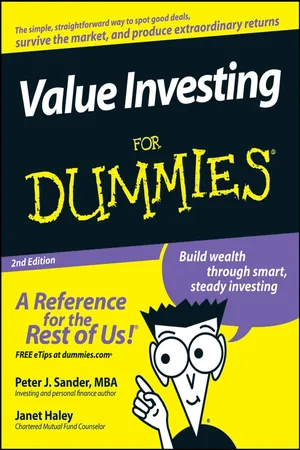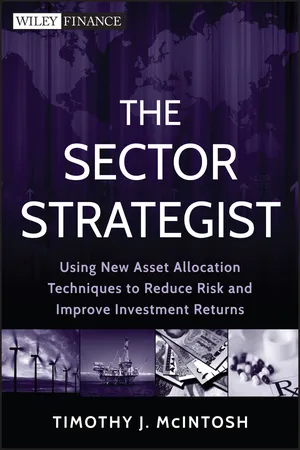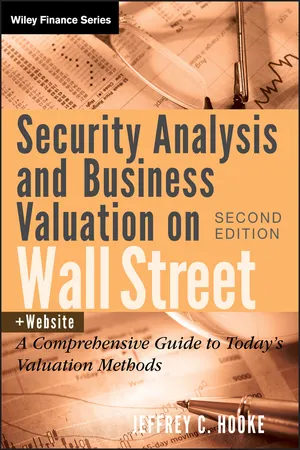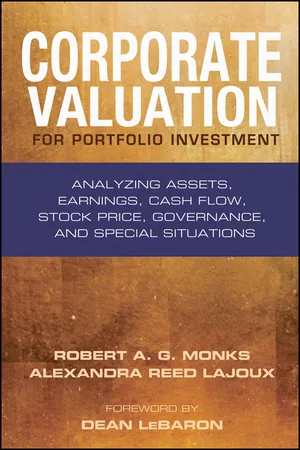Business
Stock Valuation
Stock valuation is the process of determining the intrinsic value of a company's stock. It involves analyzing various financial metrics, such as earnings, cash flow, and growth potential, to assess whether a stock is undervalued or overvalued. Common methods of stock valuation include price-to-earnings ratio, discounted cash flow analysis, and comparable company analysis.
Written by Perlego with AI-assistance
Related key terms
7 Key excerpts on "Stock Valuation"
- eBook - ePub
Value Investing in Growth Companies
How to Spot High Growth Businesses and Generate 40% to 400% Investment Returns
- Rusmin Ang, Victor Chng(Authors)
- 2013(Publication Date)
- Wiley(Publisher)
Chapter 7
Valuation—The Fourth Piece of the Puzzle
The Valuation of a Stock
The fourth and final piece of the puzzle is valuation —the financial projection. This is the most important piece to access once the other three pieces have been addressed. Here, valuation is what we call the final part of assessment before buying into a stock. Needless to say, every stock has a price tag. So, at what price is a stock considered cheap? This chapter serves to answer this question.Though we cannot expect to buy a stock at its absolute bottom, for example, in the 2008–09 crash, when the Straits Times Index (STI) was at its lowest, at 1,500 points, and sell it at its peak in 2010, when the STI had recovered to above 3,300 points, we can avoid doing the opposite. Many investors commit the mistake of buying high, when someone they know is supposedly making a killing in the stock market, and selling low, when prices start to dive. Now that you are aware that Mr. Market is subject to mood swings, you need to know how to make full use of its irrationality, in order to purchase stocks at bargain prices and sell when others are ready to pay a premium price. In order to do this, you need to know how to calculate the intrinsic value of the company based on a certain set of assumptions. Valuation can help you achieve this, so that you can buy a growth company when it is trading at a discount from its intrinsic value.In relation to the valuation of a stock, there are three types of valuation methods that we often use to determine growth companies:Now let us go through these valuation methods one by one.1. Price-to-Earnings Ratio (PE Ratio)2. Price-to-Earnings to Growth Rate Ratio (PEG Ratio)3. Discounted Earning ModelWhy Earnings Are UsedWhen valuing a growth company, it is best to use a metric like earnings per share instead of operation cash flow. This is because growth companies tend to spend more on development costs to expand their businesses further, causing the operation’s cash flow to be plowed back into the business. However, some companies are good at manipulating earnings when they do business on credit with debtors. Such manipulation is short term. In the long run, the company’s true colors should reveal themselves. To ensure that we have an accurate assessment of a company, it is important for us to obtain a track record that goes back a minimum of three to five years. Healthy numbers reported in the past do not imply that a company will stay healthy into the future. However, such figures are definitely easier to interpret and project into the future, as compared to a company that reports inconsistency in its revenue, net profit, and cash flow. This inconsistency makes it extremely hard to value or project the company into the future when determining its intrinsic value. Again, consistency is a key quality when comparing these numbers. - eBook - ePub
- Scott Kays(Author)
- 2011(Publication Date)
- Wiley(Publisher)
CHAPTER 10 Valuing Stocks Most investors utilize simplistic valuation techniques that require little time and effort. As we will see shortly, most of those methods are flawed and frequently yield inaccurate results.Faulty analysis can produce two types of poor investment decisions: Valuing a company too richly increases the probability you will overpay for it. Conversely, significantly undervaluing a security may cause you to pass on a compelling investment opportunity because you think its price is too high. Without a reasonable idea of what a firm is worth, obtaining a strong return from an investment becomes a matter of chance.Computing a stock’s fair value does not so much establish a single number that represents the company’s exact worth as it helps you determine the business’s worth to you—it tells you what you can pay for the firm and still generate the return you need. Stated differently, the intrinsic value figure places a worth on a security’s projected cash flow based on the available alternatives. Calculating stocks’ fair values also lets you compare the relative valuations of companies to each other.Since the cash flows of corporations drive their values, a time-tested method for determining a firm’s worth involves calculating a current value for all of its expected future income. The math used to calculate the present value of a firm’s future earnings is relatively simple, but it requires an understanding of two basic concepts: (1) the future value of a present sum of money and (2) the present value of a future income stream.THE FUTURE VALUE OF MONEYWould you rather receive $1 today or $1.10 a year from now? The answer depends on the return you can earn on $1. If you can earn 7 percent, today’s $1 would be worth $1.07 a year from now, making the guaranteed $1.10 more attractive. Conversely, if you can invest at 15 percent, taking the $1 now makes more sense.Let’s assume you can invest at 7 percent. The future value of $1 in one year would be $1.07. The $1 would grow to $1.14 in two years, and so on. By varying the interest rates and time periods, you can develop a future value table, such as the one found in Table 10.1 - eBook - ePub
- Peter J. Sander, Janet Haley(Authors)
- 2011(Publication Date)
- For Dummies(Publisher)
Part III
So You Wanna Buy a Business?
In this part . . .W e help you to assess or appraise the value of a company and relate that value to a stock price. We examine some of the proven methods of business value assessment, including intrinsic value, book value, discounted cash flow, and the strategic profit formula. Then we sprinkle in a dash of intangibles (investors shouldn’t live by numbers alone) and discuss buy and sell decisions. To bring these tools and techniques together into a system, we use none other than the full example of the master, Warren Buffett. Finally, to provide practice and reinforcement, we present case studies of value, and for further reinforcement, we resort to the age-old technique of showing opposites: examples of un value.Passage contains an image
Chapter 11
Appraising a Business
In This Chapter
Understanding the difference between business valuation and Stock ValuationConsidering factors driving business valueBuilding a business valuation methodologyI f you compare Value Investing For Dummies to a fancy restaurant meal, then Chapters 1 through 10 provide the table, dishes, silverware, menu, appetizers, wine, bread, and ambience. These chapters give the value investing context and approach, as well as a “menu” of basic tools commonly used to evaluate a company’s performance.But the ingredients alone don’t create a dining experience. It must all be put together. This chapter moves forward to the main course: using what you discover about a business to appraise it as an investment. Value investors strive to understand what a business is worth before making an investment decision.But this main course isn’t all that simple: It could be a college - eBook - ePub
The Sector Strategist
Using New Asset Allocation Techniques to Reduce Risk and Improve Investment Returns
- Timothy J. McIntosh(Author)
- 2012(Publication Date)
- Wiley(Publisher)
1 looked at dividend yield and overall performance of the largest 750 U.S. stocks over forty years. Stocks with above-average dividend yields outperformed those with below-average yields by 2.0% over a 1-year holding period, 6.3% over a 3-year holding period, and 9.8% over a 5-year holding period. Much of the outperformance not only comes from the added income component that high dividend stocks maintain, but also the strong defensive capability of these stocks. According to S&P 500 Index data from 1930 to 2008, stocks decline an average of −13.6% in falling markets. However, during these same time periods, dividends return an average of +4.5%—offsetting about one third of market losses. The stability of dividend paying stocks is no doubt due to the ability of the firm to pay out a significant percentage of net income in dividends, rain or shine. I recommend that a large percentage of your stock portfolio be devoted to firms that pay dividends. It will provide an additional safety net and added income during poor market cycles like 2008/2009.Intrinsic and Relative ValuationThere is a further bifurcation within the valuation process. Two additional methods for evaluating the stock price of a company are available: absolute valuation and relative valuation. Absolute valuation models, such as the dividend discount or discounted cash flow models, rely on data from the given firm followed by a forecast of future streams of earnings, dividends, or cash. In regard to absolute models, the discounted cash flow method is the most popular. Money managers and academics have been using it for decades, coming up with numerous variations: the dividend–discount model (best suited for companies paying dividends) and the discounted cash flow to the firm model (DCF) being the most popular. Investment bankers also use these models to price companies involved in mergers or acquisitions.These models, with their various permutations, represent an attempt to do the same two things: The first is to look at factors such as growth rates and profit margins to project how much money a company can generate in the future; the second is to discount the future cash flows back to today's dollars. The difficulty in these models is the substantial differences that result by making only small changes in the inputs. While this method is philosophically correct, it is a very impractical model. Therefore, I recommend a relative value approach to Stock Valuation. Relative valuation models use the previously mentioned ratios, such as P/E, P/S, PEG, and so forth.Relative value seeks to determine the true value of a stock by comparing these multiples to those of the overall market, similar firms, or the company's own history. For example, if two companies participate in the same industry, with comparable balance sheets and income statements and equal growth rates, their P/Es should be very similar. If their P/Es are different, an analyst must investigate why such a discrepancy exists. Each company also has a trading history. Stocks will trade either below, equal to, or above their own historical valuation. Finding stocks that trade at a low historical valuation can offer an investor substantial rewards. In the previous chapters on the sectors, I have given you several case studies that use fundamental valuation techniques. - eBook - ePub
Security Analysis and Business Valuation on Wall Street
A Comprehensive Guide to Today's Valuation Methods
- Jeffrey C. Hooke(Author)
- 2010(Publication Date)
- Wiley(Publisher)
2. Macroeconomic Review 3. Relevant Stock Market Prospects 4. Review of the Company and Its Business 5. Financial Analysis 6. Financial Projections7. Application of Valuation Methodologies8. RecommendationRecall the five broad approaches to business valuation (reiterated in Exhibit 12.1 ). Of these, only the first four lend themselves to the quasi-scientific method outlined in this book. They forecast stock prices on the basis of historical economic, capital market, industry, and company statistics, which are then used to establish predictive trends for a firm’s operating performance and stock price.EXHIBIT 12.1Business Valuation MethodologiesASSESSING EACH METHODOLOGY
The four methodologies covered in this book have positive and negative attributes that are summarized here:Intrinsic Value (Discounted Cash Flow, or DCF)+ Intrinsic value is theoretically appropriate and the subject of many textbooks. + Corporate lenders use DCF on a regular basis for pricing loans and fixed-income securities. - Equity professionals are reluctant to emphasize DCF. It is heavily reliant on 5-to 10-year projections. Forecasts are notoriously inaccurate past 1 year, much less 5 to 10 years. - eBook - ePub
Corporate Valuation for Portfolio Investment
Analyzing Assets, Earnings, Cash Flow, Stock Price, Governance, and Special Situations
- Robert A. G. Monks, Alexandra Reed Lajoux(Authors)
- 2010(Publication Date)
- Bloomberg Press(Publisher)
reflexivity.We’ll look at each of these seven approaches to valuation based on stock price, and then, after a brief discussion of the equity premium, conclude with our usual “lens” on value.Approach 1: Ratios or Formulas That Include Stock Prices
Fundamental analysts look at stock price in relation to financial reports, and they buy stocks that have a low stock price in relation to reported financials (e.g., a low price-to-earnings or conversely a high earnings per share). If you want to know what the stock price tells you, factoring in fundamentals—or value—is always a good idea. The most famous investor known for this approach is Warren Buffett, but he’s not the only practitioner. A whole class of mutual funds advertise themselves as “value funds”—funds that buy stock with a low ratio of stock price to key accounting variables, such as the price-to-earnings (P/E) ratio.To maintain a fundamentalist view of stock performance, an investor must have reasonable confidence in three key propositions:1. Financial statements reflect current financial performance. 2. Past financial performance can help predict future financial performance. 3. Stock prices respond to reported financial performance.These assumptions are true enough to be useful, but each requires a caveat:1. Regarding the first proposition, as seen in previous chapters, financial statements do not (and are not intended to) mirror financial performance exactly. Interpretation is required.2. As for the second proposition, history’s lesson is that past performance provides clues, but no guarantees. Even if financial statements could mirror performance exactly, the past is not the same as the future.3. Finally, as for the third proposition, stock prices do not always respond in the same way to reports of financial performance. - eBook - ePub
- Alan R. Simon(Author)
- 2010(Publication Date)
- For Dummies(Publisher)
If you exercise options and you believe that for whatever reason, your company’s stock is highly overvalued, then you would likely want to sell those shares immediately even if you’ll pay higher tax rates than if you hold those shares for several years. Conversely, if you believe that your company’s stock is undervalued or fairly valued, you might choose to exercise options but hold those shares because you believe the chance of a major price slide is negligible. Or, at the very least, any major price slide would be because of overall economic or market conditions rather than the investing public suddenly coming to their senses and unloading your company’s shares en mass.Enough generalities. How can you try to figure out the overvaluation-undervaluation situation? There are many, many formulas you can use, each of which has its strengths and shortcomings. Two of these formulas are:Price-earnings ratio: One of the classics — in which your company’s stock price is compared against its earnings per share, either historically (often the past 12 months) or against projected earnings (for example, projections for the next 12 months). Basically, the higher the ratio, the more expensive the stock is. However, a key shortcoming of valuation based on price-earnings ratios is that one company growing much faster than its competitors or other similar companies might “deserve”a higher price-earnings ratio than those slower-growing companies.Price-sales ratio: Basically substituting a company’s revenue (sales) per share for earnings, and calculating a ratio just as you would for price compared to earnings. Price-sales ratios are useful to try to determine the value of a company that doesn’t yet have positive earnings (that is, it’s still losing money). The same deal applies: The higher the ratio, the more expensive the stock is. However, a chief shortcoming is that price-sales ratios don’t take into consideration if a company will ever have positive earnings.You can find many other ratios and formulas that you can use. Check out Investing For Dummies
Index pages curate the most relevant extracts from our library of academic textbooks. They’ve been created using an in-house natural language model (NLM), each adding context and meaning to key research topics.
